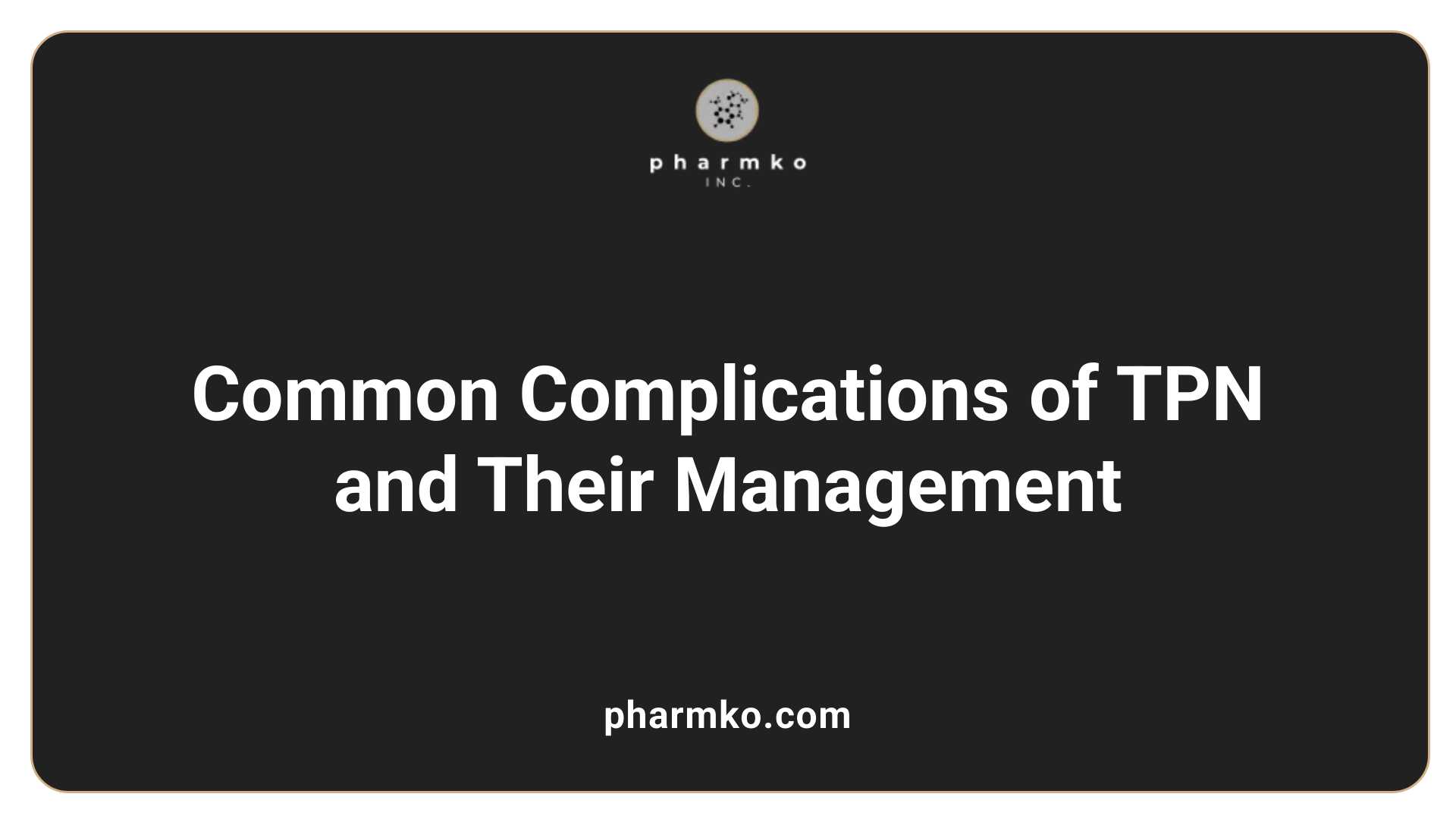What to Do When TPN is Not Meeting Nutritional Goals: Alternative Strategies

Introduction
Total Parenteral Nutrition (TPN) is a life-saving intervention for individuals whose gastrointestinal tracts cannot absorb nutrients effectively. However, what happens when TPN itself falls short of meeting nutritional goals? This article delves into alternative strategies, addressing adjustments and interventions tailored to different patient needs. From exploring the viability of Peripheral Parenteral Nutrition (PPN) to adjusting nutrient compositions, healthcare providers must navigate a complex landscape to effectively meet patient nutritional requirements. In this discussion, we examine key considerations and solutions for transitioning away from TPN when necessary, focusing on safety, efficacy, and patient-centered care.
Alternative Nutrition Options to TPN

What are some alternative nutrition options to TPN?
Alternative nutrition strategies to Total Parenteral Nutrition (TPN) include Clinimix and Peripheral Parenteral Nutrition (PPN). These options cater to patients who require intravenous nutritional support without the complexities associated with long-term TPN usage.
Difference between TPN and other intravenous nutrition methods
- Total Parenteral Nutrition (TPN) is specifically designed to meet all nutritional requirements for patients who cannot absorb nutrients through their gastrointestinal tract. It is delivered via a central venous catheter and is typically used for long-term support.
- Clinimix: This is a preformulated intravenous nutrient solution aimed at providing essential macronutrients—such as carbohydrates, proteins, and fats—along with vitamins and minerals. Clinimix can be beneficial for patients recovering from surgery or those critically ill unable to consume adequate nutrition.
- Peripheral Parenteral Nutrition (PPN): Generally considered for short-term use (up to two weeks), PPN is less concentrated than TPN. It is delivered via peripheral veins and is suitable for patients whose gastrointestinal tracts are partially functional, thus requiring only supplemental nutrition.
Overview of Clinimix and Peripheral Parenteral Nutrition (PPN)
| Method | Nutritional Coverage | Administration Duration | Clinical Use |
|---|---|---|---|
| TPN | Full Nutritional Needs | Long-term (>2 weeks) | Non-functional GI tract |
| Clinimix | Essential macronutrients & micronutrients | Variable | Postsurgical recovery, critically ill |
| PPN | Partial Nutritional Needs | Short-term (up to 2 weeks) | Patients with partial GI function |
Considerations for choosing alternative options
When selecting between alternative nutritional options, several factors must be considered, including:
- Patient's medical conditions: Certain health issues may preclude the use of certain methods.
- Nutritional requirements: Understanding the specific needs for recovery or maintenance is crucial.
- Duration of nutritional support: Short-term vs long-term needs must be evaluated.
In summary, Clinimix and PPN are valuable alternatives for patients whose needs may not warrant the more invasive TPN approach, helping to minimize risks and improve patient outcomes.
Immediate Actions When TPN Supplies Run Low

What should be done if a patient runs out of TPN?
If a patient runs out of TPN, it is essential to infuse D10W (a 10% dextrose solution) at the same rate until a new TPN solution is available. This interim solution provides necessary calories and helps prevent hypoglycemia. Communication is critical; the healthcare team, including pharmacists and dietitians, must be immediately notified to arrange for the prompt preparation and delivery of a revised TPN solution, particularly if a delay is expected to exceed 24 hours.
Temporary solutions to maintain nutritional intake
During the waiting period for the new TPN supply, closely monitor the patient’s clinical status. Regular assessments should include:
- Weight checks
- Electrolyte levels
- Signs of malnutrition Continuous evaluation allows healthcare providers to make necessary adjustments to the interim plan and address potential complications swiftly.
Importance of coordinated healthcare efforts
Coordinated efforts among healthcare team members are vital to ensure seamless care. Effective communication channels should be established across nursing, pharmacy, and dietary departments to provide timely interventions. This minimizes the likelihood of disruptions in nutritional support and ensures patient safety while adhering to policy guidelines for parenteral nutrition.
Nursing Interventions for TPN Patients

What are the key nursing interventions for patients on TPN?
Nurses play a vital role in managing patients on Total Parenteral Nutrition (TPN). Their primary interventions include:
- Regular Monitoring: Frequent checks of the patient's nutritional status and metabolic response are crucial. This includes tracking weight, vital signs, and laboratory values like electrolyte levels and blood glucose concentrations.
- Technique Adherence: TPN is administered through a central venous catheter, so nurses must ensure sterile techniques during administration to prevent infections.
- Observing for Complications: Key complications like catheter-related infections, refeeding syndrome, electrolyte imbalances, and hyperglycemia should be monitored closely. Early detection leads to timely management.
- Individualized Care Plans: Developing care plans that consider each patient's specific nutritional needs and health challenges is essential for successful outcomes. This includes adjusting nutrient formulations based on metabolic demands and patient responses.
Prevention of TPN-related complications
To prevent complications associated with TPN, nurses should be vigilant in their assessments. Some methods include:
- Gradual Infusion Rate Increase: When initiating TPN, start at a lower infusion rate and increase gradually to avoid refeeding syndrome, especially in malnourished patients.
- Fluid and Electrolyte Management: Regular blood tests should be conducted to monitor fluid balance and electrolyte levels, facilitating necessary adjustments to the TPN formula.
- Education: Informing patients and families about TPN and signs of complications empowers them to participate in their care actively.
Developing patient-centered care plans
Creating effective, patient-centered care plans involves:
- Interdisciplinary Collaboration: Regular communication with dietitians, physicians, and other healthcare professionals is crucial to ensure comprehensive care.
- Personalized Goals: Setting realistic nutritional goals considering the patient's medical history, current health status, and potential for recovery is vital in guiding the TPN therapy.
- Empowerment: Engaging patients in their nutrition goals increases adherence to the care plan and enhances their overall satisfaction with the treatment process.
Managing Complications Associated with TPN

What are common complications associated with TPN and how are they managed?
Total parenteral nutrition (TPN) is a crucial intervention for patients with nonfunctional gastrointestinal tracts, but it comes with several associated complications. Common issues include dehydration, electrolyte imbalances, hyperglycemia, hypoglycemia, infections, liver dysfunction, and micronutrient deficiencies.
Metabolic Complications:
Hyperglycemia affects nearly 50% of TPN patients, often requiring stringent glycemic management, which may include the addition of insulin to their TPN formula. Conversely, hypoglycemia can occur, particularly in patients receiving insulin, necessitating regular blood glucose monitoring. To minimize metabolic derangements, adjustments to the TPN formulation may be made, altering the nutrient composition as needed.
Refeeding Syndrome:
A critical concern is refeeding syndrome, which arises when TPN is introduced too quickly to patients who have been severely malnourished. Gradual initiation of TPN and careful monitoring of electrolytes are essential to mitigate this risk.
Infection Risks:
Given the reliance on central venous catheters for TPN administration, the risk of central line-associated bloodstream infections must not be overlooked. Strict adherence to aseptic techniques and regular monitoring of insertion sites can substantially reduce this risk.
Monitoring and Adjustment:
Proactive management is key to preventing complications. Continuous monitoring of blood glucose, electrolytes, and hepatic function allows healthcare providers to make informed adjustments to the TPN as needed, ensuring patient safety and optimizing nutritional support. Regularly scheduled lab tests help identify any emerging issues quickly, fostering timely interventions.
Adjusting TPN for Risk Levels of Undernourishment
Tailoring TPN to Individual Patient Needs
Total Parenteral Nutrition (TPN) must be meticulously tailored to meet each patient's nutritional requirements. This tailoring starts with a comprehensive assessment that considers factors like organ function, stress levels, and the patient's ideal body weight. For patients identified as being at moderate to high risk of undernourishment, adjustments are critical. TPN should be initiated slowly, allowing for titration that increases the infusion rate gradually over four to seven days. This cautious approach helps to mitigate the risks commonly associated with TPN, such as refeeding syndrome and hyperglycemia.
Importance of Gradual Integration of Nutrition
The gradual advancement of TPN rates is vital to accommodate the body's response. During this period, healthcare providers should monitor electrolytes and overall metabolic status keenly. Adjustments should be based on daily evaluations of caloric needs and any emerging complications from the TPN administration—especially for those patients who may have struggled with malnutrition prior to therapy.
Monitoring and Adjusting Due to Patient Responses
Effective TPN management mandates stringent monitoring of blood glucose levels and electrolytes. Any signs of complications necessitate immediate reassessment of the TPN formulation and administration strategy. Adherence to aseptic techniques is essential to prevent infections and promote catheter patency. In sum, careful monitoring and responsive adjustments are integral in optimizing TPN outcomes for patients at risk of undernourishment.
Transitioning from TPN: A Stepwise Approach
Criteria for the transition from TPN to oral/enteral feeding
Transitioning from total parenteral nutrition (TPN) to oral or enteral feeding is an important step that requires thorough assessment. Healthcare providers consider several factors when determining patient readiness. These include monitoring the nutritional status, evaluating the functionality of the gastrointestinal system, and reviewing the patient’s overall health status, including medical history and current medications.
Ideal candidates for weaning off TPN are those who show:
- Stable body weight
- Improved nutritional markers
- Ability to adequately meet their nutritional needs through oral or enteral routes
- Good overall health
Developing a weaning plan based on patient health
Formulating a weaning plan is crucial to ensure a smooth transition. The timeline for reducing TPN should be gradual and personalized to each patient’s specific health needs. This approach helps mitigate risks such as rebound hypoglycemia, which can arise from abrupt changes in nutrition. Monitoring the patient's nutritional intake and health status throughout the process is essential to adjust the plan as needed.
Role of patient involvement in transition
Involving patients in their transition from TPN is key to their success. Engaging patients in decision-making fosters empowerment and can significantly impact adherence to the new nutrition plan. This involvement ensures that patients actively participate in discussions about their dietary preferences, tolerance, and any concerns, leading to better outcomes during the switch to oral nutrition.
Ultimately, a coordinated approach that includes careful monitoring and patient involvement can lead to successful transitioning from TPN to other forms of nutrition.
Addressing the Needs of Patients with Specific Health Conditions
Considerations for renal impairment and other conditions
Patients with specific health conditions, particularly those with renal impairment, often necessitate unique adjustments in their TPN plans. For instance, during acute renal failure, it is critical not to restrict protein intake indiscriminately. Critically ill patients still require adequate protein to meet their metabolic needs, despite their renal condition.
Importance of tailored nutritional strategies
The optimization of nutritional strategies becomes even more evident when incorporating specialized nutrients. Patients experiencing complications like intestinal failure-associated liver disease (IFALD) may benefit significantly from using specialized lipid formulations, such as omega-3 fatty acids. Research indicates that these lipids can provide liver protection and enhance adaptation of the intestine, ultimately aiding the transition from TPN to enteral feeding.
Case examples demonstrating effectiveness
To illustrate the effectiveness of tailored nutritional strategies:
- Acute renal failure: TPN not limiting protein can improve recovery outcomes.
- Intestinal failure: The introduction of omega-3 fatty acids in TPN demonstrates potential to enhance liver health and facilitate gradual transition from parenteral to enteral nutrition.
| Condition | Nutritional Strategy | Benefits |
|---|---|---|
| Acute renal failure | Adjusted protein intake | Meets metabolic needs in critically ill |
| Intestinal failure | Specialized omega-3 lipids | Provides liver protection and promotes adaptation |
These examples underscore the necessity of individualized nutritional approaches in TPN therapy, ensuring each patient's treatment plan aligns with their specific health circumstances and metabolic requirements.
Research and Clinical Recommendations for Alternative Interventions

What are research findings or clinical recommendations on alternative nutrition interventions when TPN is not meeting goals?
Recent studies underscore that Total Parenteral Nutrition (TPN) may not be the optimal choice for all patients, especially those undergoing cancer treatments such as chemotherapy and radiation. Evidence suggests that TPN may lead to complications that could potentially diminish survival rates, highlighting the importance of exploring timely alternative nutrition strategies for these patients.
The European Society for Clinical Nutrition and Metabolism (ESPEN) emphasizes adherence to evidence-based guidelines in treating patients with intestinal failure. This underscores the significance of regularly assessing nutritional needs and adjusting approaches when TPN does not adequately fulfill these needs.
In pediatric populations, research indicates promising results with intravenous omega-3 lipid formulations. Such interventions appear to assist in promoting intestinal adaptation, which could facilitate transitions from TPN to oral nutrition. This area of research has the potential to refine current practices and improve recovery trajectories.
Additionally, clinical recommendations advocate for integrating enteral nutrition whenever the gastrointestinal tract is functional, as it generally poses fewer risks and is more cost-effective than TPN. This approach not only supports patient safety but also optimizes nutritional outcomes post-TPN. Overall, these insights stress the importance of ongoing research and clinical vigilance in adapting nutritional support strategies to enhance patient care.
Decision-Making for Nutritional Support
What factors should healthcare providers consider in making decisions for nutritional support when TPN fails?
When TPN does not adequately meet a patient’s nutritional needs, healthcare providers need to assess various factors before transitioning to alternative nutritional strategies. This assessment includes reviewing the patient’s preexisting nutritional status, the impact of their disease, and the potential for improved outcomes or quality of life with alternative methods.
Providers must weigh the risks and benefits of continuing with TPN, which may involve severe complications such as infection or liver disease, against transitioning to enteral nutrition or other feeding methods. Enteral nutrition is typically more cost-effective and carries a lower risk of infections compared to TPN.
Patient-centered approaches in nutritional planning
Involving patients in decision-making is crucial. Tailored approaches should consider individual factors, such as:
- Health Condition: Evaluating any underlying health issues, like renal impairment, which might necessitate specific adjustments in nutritional support.
- Personal Preferences: Understanding the patient’s willingness to shift towards oral or tube feeding can promote adherence and satisfaction.
- Nutritional Readiness: Monitoring their ability to tolerate enteral feeds, consolidating a plan based on their current health status and response to nutrition.
Evaluating risks and benefits of alternative strategies
Transitioning away from TPN requires careful planning. Potential alternatives like Peripheral Parenteral Nutrition (PPN) or oral nutrition need to be considered depending on how well the patient's gastrointestinal function can support their nutritional intake.
An ongoing evaluation of symptoms such as fatigue or weight loss should guide healthcare providers in refining the nutritional approach, ensuring it aligns with the patient’s evolving needs and health conditions. Regular monitoring will help to mitigate complications during this transition phase.
Monitoring and Management of TPN-Related Nutritional Deficiencies
Signs and symptoms of malnutrition in TPN patients
Patients receiving Total Parenteral Nutrition (TPN) can experience signs of malnutrition, which necessitates vigilant monitoring. Some common symptoms include:
- Fatigue: A general lack of energy can indicate inadequate nutrient intake.
- Unintended weight loss: Gradual or significant weight loss should raise concerns regarding nutritional status.
- Decreased urine output: This may signal dehydration or electrolyte imbalances.
- Impaired immune function: Increasing frequency of infections can suggest nutritional deficiencies.
Intervention strategies for addressing deficiencies
When signs of malnutrition emerge during TPN therapy, several intervention strategies can be employed:
- Nutritional assessment reviews: Regular evaluations of dietary intake and caloric needs help tailor TPN formulations.
- Adjusting TPN composition: Modifying the mix of carbohydrates, proteins, and lipids ensures nutrients align with patient requirements.
- Supplementation: Adding vitamins and minerals as per individual needs helps to rectify deficiencies.
- Fluid management: Adjusting fluid volumes based on patient conditions prevents dehydration and fluid overload.
Importance of continuous monitoring during TPN therapy
Continuous monitoring during TPN administration is critical for the early detection of nutritional deficiencies and health complications. Healthcare providers should:
- Conduct frequent laboratory tests: These tests are vital for tracking electrolyte levels and metabolic status.
- Assess patient intake regularly: Ongoing evaluations of nutritional intake can help adjust the TPN plan accordingly.
- Monitor patient responses and adjust care accordingly: Prompt attention to changes allows timely interventions to prevent serious complications.
| Intervention Strategy | Purpose | Key Actions |
|---|---|---|
| Nutritional assessment reviews | Tailor TPN formulations | Regular evaluations of dietary intake |
| Adjusting TPN composition | Align nutrients with patient needs | Modify macronutrient ratios |
| Supplementation | Rectify nutritional deficiencies | Add vitamins and minerals as needed |
| Fluid management | Prevent dehydration/fluid overload | Adjust fluid volumes based on status |
Monitoring for signs of malnutrition and dehydration during TPN therapy is essential, as these conditions can manifest through symptoms like fatigue, unintended weight loss, or decreased urine output. Healthcare providers must regularly assess the patient’s nutritional intake, monitor for complications such as dehydration or electrolyte imbalances, and make necessary adjustments to the weaning plan based on patient responses. Implementing frequent lab tests is crucial in catching early signs of these issues. Both nutritional and supplemental interventions can be strategically utilized to prevent deficiencies, promoting patient health and stability during TPN use.
Factors Affecting TPN Effectiveness and Adjustments
Challenges in Maintaining TPN Effectiveness
Total parenteral nutrition (TPN) is a complex intervention that does not suit all patients uniformly. Various factors can jeopardize its effectiveness. For instance, patients with conditions like new-onset diabetes, liver disease, or renal impairment may experience shifts in their nutritional needs.
Tailoring TPN to Adapt to Changing Patient Conditions
Healthcare providers must frequently assess the patient’s status and adjust TPN accordingly. This could involve modifying the macronutrient composition — that is, adjusting levels of proteins, carbohydrates, and fats within the PN formulation. If a patient shows signs of hyperglycemia, incorporating insulin into their TPN regimen becomes essential for effective management. Likewise, maintaining fluid and electrolyte balance is critical, particularly during periods of significant fluid loss.
Clinical Interventions to Enhance TPN Therapy
Regular evaluations, including monitoring of laboratory values and blood glucose levels, are crucial to ensure that TPN remains effective over time. Issues like refeeding syndrome and electrolyte imbalances necessitate cautious adjustments in feeding rates and nutrient composition. Ultimately, a tailored approach that responds to individual health fluctuations enhances TPN effectiveness, enabling better patient outcomes.
| Intervention Type | Description | Recommended Action |
|---|---|---|
| Nutrient Composition Adjustment | Change macronutrient ratios to better meet individual metabolic needs. | Monitor conditions like diabetes or renal issues. |
| Blood Glucose Monitoring | Regular checks to prevent hyperglycemia. | Include insulin if levels rise significantly. |
| Fluid and Electrolyte Management | Adjust fluids based on loss due to health conditions (vomiting/diarrhea). | Regularly assess and modify TPN formula as needed. |
Adjustments to TPN are instrumental in aligning with individual patient responses, ensuring optimal nourishment is maintained.
Exploring Intestinal Failure and Long-Term TPN Use
What is the role of TPN in managing different types of intestinal failure, and what are the long-term implications of its use?
Intestinal failure is classified into three types:
- Type I: Acute and self-limiting conditions requiring short-term support.
- Type II: Prolonged acute conditions necessitating complex nutritional care.
- Type III: Chronic conditions that demand long-term Total Parenteral Nutrition (TPN).
Total Parenteral Nutrition plays a vital role in managing patients with intestinal failure. It provides essential nutrients intravenously when patients cannot achieve adequate nutrition through oral or enteral routes. TPN ensures these patients receive proteins, carbohydrates, fats, vitamins, and minerals necessary for survival.
Despite its life-saving benefits, long-term TPN usage carries significant risks. Complications can include:
- Blood infections: Particularly due to the need for central venous catheters.
- Loss of venous access: Repeated use can damage veins and complicate future access.
- Liver problems: Conditions such as Intestinal Failure-Associated Liver Disease (IFALD) can develop due to prolonged infusion.
The complexities inherent in TPN necessitate careful monitoring and management. Healthcare providers must remain vigilant to address these potential complications while enhancing patient quality of life through advanced nutritional strategies.
Conclusion
Total Parenteral Nutrition (TPN) remains a vital tool in modern medicine, particularly for patients with severe gastrointestinal challenges. Nevertheless, its inability to meet nutritional goals in certain scenarios necessitates alternative strategies to ensure comprehensive care. By exploring peripheral options, carefully monitoring patient responses, and aligning treatment plans with evolving clinical evidence, healthcare providers can effectively address TPN inadequacies. The persistent focus on patient-centered approaches, innovative nutritional solutions, and robust clinical oversight will continue to drive improved outcomes and enhanced quality of life for patients requiring complex nutritional support.
References
- Total Parenteral Nutrition - StatPearls - NCBI Bookshelf
- [PDF] The Hitchhiker's Guide to Parenteral Nutrition Management for Adult ...
- How to Wean from TPN in Adults - AmeriPharma® Specialty Care
- Parenteral Nutrition Overview - PMC - PubMed Central
- Decision-Making for Alternate Nutrition and Hydration - Part 2
- Parenteral Nutrition - BAPEN
- Specialized Nutrition Support - AAFP




































































































